Birds are a vibrant and vital part of Turkana’s unique and diverse wildlife. The region is home to over 400 species of birds, ranging from vibrant flamingos to majestic raptors, providing a colorful addition to the landscape.
The Ewaso Ng’iro River, with its many lakes and wetlands, is a necessary feeding and breeding ground for many species of birds, making the region an excellent destination for bird-watching.
The area is also home to several endangered species, including the Taita Apalis and the threatened Basra Reed Warbler.
With its diverse habitats, open plains, and abundant food sources, Turkana is a haven for bird lovers looking to observe and learn about these beautiful creatures.
22 Birds to Watch in Turkana
Turkana is a region in northern Kenya that is known for its arid and harsh landscape, but also for its rich and diverse wildlife. Among the many animals that live in Turkana, birds are especially abundant and varied, making the region a great destination for bird-watching enthusiasts.
Here are 22 birds that you can watch in Turkana
1. Yellow-billed Stork
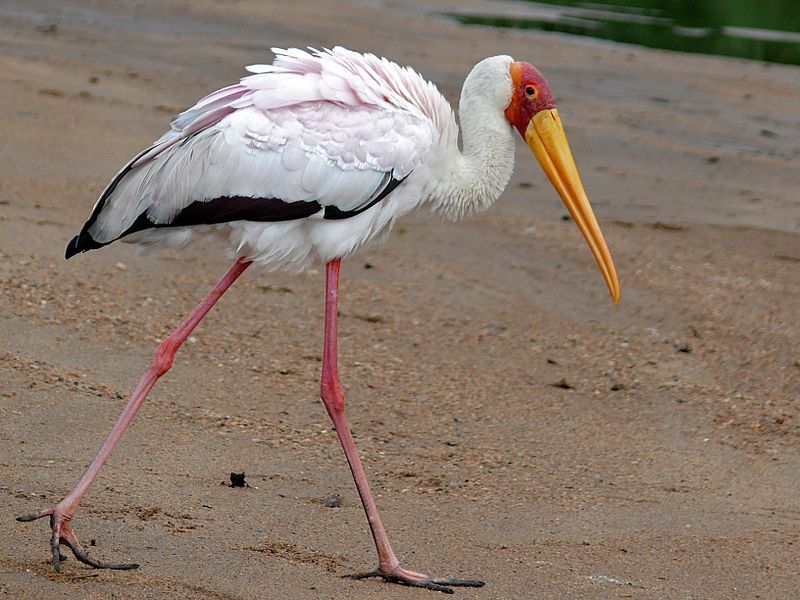
The yellow-billed stork is a large species of wading bird found in Africa and Madagascar. It is part of the Ciconiidae family and is also known as the wood stork or ibis. It is widespread and can be found in regions south of the Sahara Desert.
The yellow-billed stork can often be seen wading in shallow pools of water in search of its favorite food, which includes fish, amphibians, and insects. Its striking yellow bill and long neck make it easily recognizable in its wetland habitat.
The species is classified as near threatened due to habitat destruction and pollution, but conservation efforts have been implemented to help protect the species.
| Kingdom | Animalia |
| Phylum | Chordata |
| Class | Aves |
| Order | Ciconiiformes |
| Family | Ciconiidae |
| Genus | Mycteria |
| Species | M. ibis |
2. Black-winged Stilt
The black-winged stilt (Himantopus himantopus) is a species of wading bird in the avocet and stilt family, found on many continents. It is a long-legged wader with legs measuring up to 1/3 of its body length.
It has distinctive black-tipped wings and white plumage. The black-winged stilt is widely distributed in Europe, Africa, Asia, and Australia. It has even been observed in South America and the Caribbean.
It is often found near salt marshes, rivers, shallow lagoons, and agricultural fields. The black-winged stilt is a solitary bird but may sometimes gather in flocks. It is an omnivore, feeding mainly on aquatic animals such as fish, insects, and crustaceans.
It also eats plant material such as seeds and fruits. The scientific name for the black-winged stilt, Himantopus himantopus, often refers to a single, almost cosmopolitan species.
This species is closely related to other species of wading birds, such as the American avocet and the red-necked stilt, with all three species belonging to the same genus. The black-winged stilt is a graceful and elegant bird.
It is often seen standing on one leg in the water, searching for food with its long, slender beak. It is an important species for conservation, as it is vulnerable to habitat destruction and pollution.
| Kingdom | Animalia |
| Phylum | Chordata |
| Class | Aves |
| Order | Charadriiformes |
| Family | Recurvirostridae |
| Genus | Himantopus |
| Species | H. himantopus |
3. Speckled Pigeon
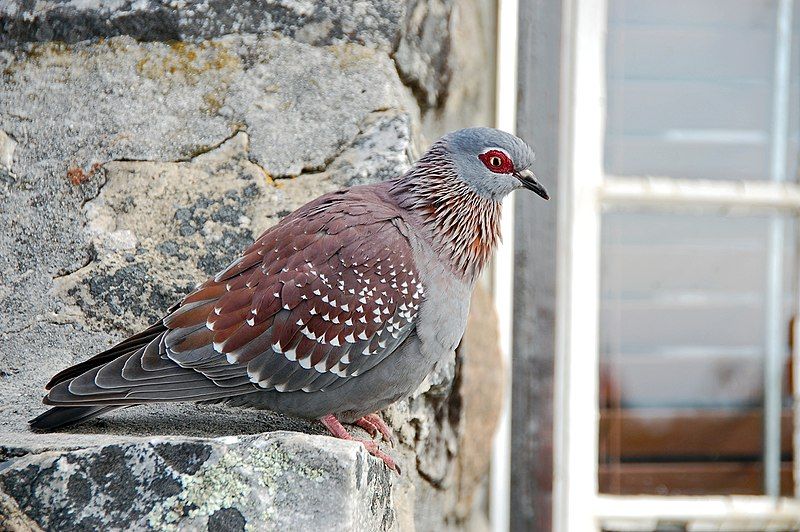
The speckled pigeon, also known as the African rock pigeon or the Guinea pigeon, is a species of pigeon found in many areas of Africa south of the Sahara Desert. It is a widespread bird that lives in open habitats such as grasslands, savannahs, and woodlands.
The speckled pigeon is easily identifiable by its speckled black-and-white feathers. The speckled pigeon is a resident breeding bird breeds in the same area year-round. It is known for its large, sturdy nests in trees, cliffs, or buildings.
These birds are gregarious, often seen in large flocks that can number hundreds. They feed on grains, grasses, and seeds and usually forage in open fields. The speckled pigeon is an important species to many African cultures as it is a famous game bird.
This species is also hunted for food and is popularly kept as a pet. Despite its wide distribution, there are still some areas where the species is absent. This is due to the destruction of its natural habitats and competition with other species.
| Kingdom | Animalia |
| Phylum | Chordata |
| Class | Aves |
| Order | Columbiformes |
| Family | Columbidae |
| Genus | Columba |
| Species | C. guinea |
4. Namaqua Dove
The Namaqua dove is a small species of pigeon found in many parts of Sub-Saharan Africa, Arabia, and Madagascar. It is the only species of its genus, called Oena, and is easily recognizable due to its distinct coloring and size.
The Namaqua dove is primarily gray with a chestnut brown back and wings. Its head and neck are white with black speckles, and its tail is tipped with a bright white. They are relatively small, measuring only about 25 centimeters in length.
The Namaqua dove is usually found in open woodland, thickets, and open grasslands, where it feeds on seeds and insects. It is a friendly bird and forms small flocks when searching for food.
It is a common sight in the African bush, often seen perched on the branches of trees or flying in search of food. Namaqua doves are monogamous, and pairs will defend their territories against intruders.
They build nests in trees or shrubs and lay two eggs, which are incubated for about two weeks. The chicks can leave the nest after about three weeks and are independent after six weeks.
The species is not considered threatened and is listed as the Least Concern on the IUCN Red List.
| Kingdom | Animalia |
| Phylum | Chordata |
| Class | Aves |
| Order | Columbiformes |
| Family | Columbidae |
| Genus | Oena |
| Species | O. capensis |
5. Ring-necked Dove
The ring-necked dove is a species of dove that is found across much of East and Southern Africa. It is a relatively widespread dove species found in various habitats, from grasslands and savannahs to woodlands and open forests.
Often found in pairs or small flocks, this dove species is primarily sedentary, rarely making long-distance migrations.
The ring-necked dove is easily identifiable by its distinctive white collar and half-collared neck markings, which is why it is sometimes referred to as the half-collared dove or Cape turtle dove.
Its back is grey-brown, its belly is light grey or buff-colored, and its tail is brown with a white tip. The song of the ring-necked dove is a series of soft, cooing notes. The ring-necked dove is a seed-eating bird, foraging on the ground for food.
It feeds on various small grains, grain-like seeds, and even small insects.
This dove species is also known to feed on berries and is often seen perched on tree branches to reach them. The ring-necked dove is an important species for African farmers, as it helps to disperse the seeds of various crops, allowing them to grow and produce more food.
This dove species is also a famous game bird and is hunted for its meat in some parts of Africa.
| Kingdom | Animalia |
| Phylum | Chordata |
| Class | Aves |
| Order | Columbiformes |
| Family | Columbidae |
| Genus | Streptopelia |
| Species | S. capicola |
6. Emerald-spotted Wood Dove
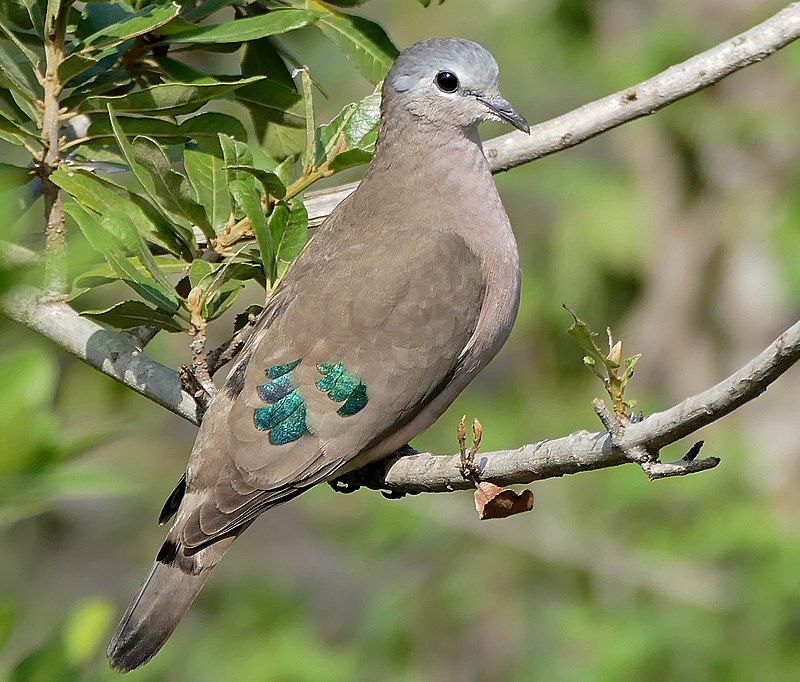
The emerald-spotted wood dove is a bird native to eastern and southern Africa. It lives in open, drier, deciduous woodlands and areas of secondary growth.
This species of bird does not inhabit evergreen rainforests or semi-desert areas. The emerald-spotted wood dove is part of the Columbidae family, which includes pigeons and doves. It is found across eastern and southern Africa but not in all the regions.
It prefers open, drier deciduous woodlands and areas featuring secondary growth. These areas are generally characterized by trees and shrubs that are still young and growing. The dove does not live in evergreen rainforests.
These types of forests are known for their dense vegetation and high moisture levels. The emerald-spotted wood dove also does not inhabit semi-desert areas.
These regions are characterized by sparse vegetation and extreme temperatures. The emerald-spotted wood dove is a species native to eastern and southern Africa. It is found mainly in open, drier deciduous woodlands and secondary growth areas.
This bird does not live in evergreen rainforests or semi-desert areas, which have different environmental conditions than the areas it prefers.
| Kingdom | Animalia |
| Phylum | Chordata |
| Class | Aves |
| Order | Columbiformes |
| Family | Columbidae |
| Genus | Turtur |
| Species | T. chalcospilos |
7. Laughing Dove
The laughing dove is a small pigeon species native to regions such as Africa, the Middle East, South Asia, and Western Australia. It is a resident breeder, meaning it builds nests and stays in the same area year-round instead of migrating.
In Western Australia, the laughing dove is particularly well-established, having been released into the wild from Perth Zoo in 1898. Since then, it has successfully established itself in the area, and its population has grown.
The laughing dove is a relatively common sight in many parts of the world and is easily recognizable by its distinctive call. It is a medium-sized bird with a gray-brown back, wings, pinkish-gray chest, and belly.
| Kingdom | Animalia |
| Phylum | Chordata |
| Class | Aves |
| Order | Columbiformes |
| Family | Columbidae |
| Genus | Spilopelia |
| Species | S. senegalensis |
8. Mourning Collared Dove
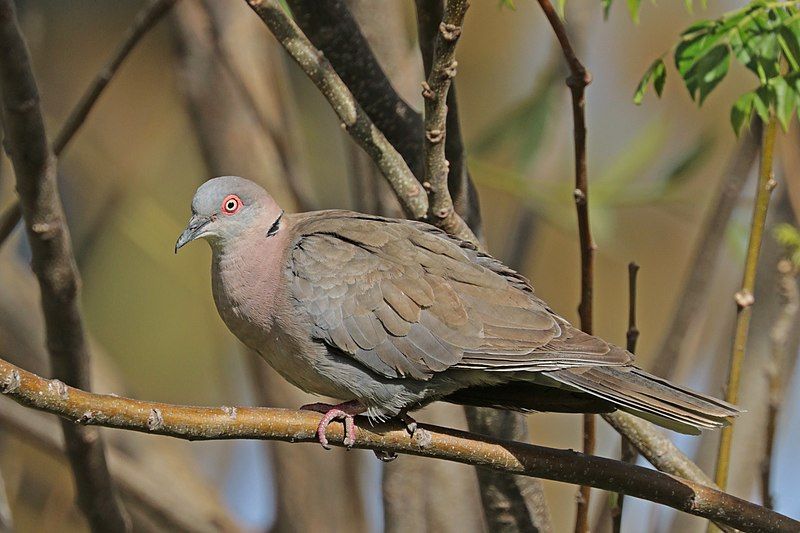
The mourning collared dove, also known as the African mourning dove, is a species native to Africa south of the Sahara. Despite its name, it has no relation to the North American mourning dove.
This species is a widespread resident breeding bird in its native area, often found near bodies of water. The mourning collared dove is usually abundant in such areas and is known for peacefully coexisting with other dove species.
Its name is derived from its distinctive black collar on the bird’s neck. Its grayish-brown coloring and white-tipped tail can also identify this species.
The mourning collared dove is a popular choice for aviaries and pet doves, as it is relatively easy to tame and is a peaceful bird.
| Kingdom | Animalia |
| Phylum | Chordata |
| Class | Aves |
| Order | Columbiformes |
| Family | Columbidae |
| Genus | Streptopelia |
| Species | S. decipiens |
9. African Green Pigeon
The African green pigeon is a bird species found in the family Columbidae. It is one of five green pigeons living in the Afrotropics, a region that includes parts of Africa and Southwestern Asia.
This bird species has a wide range of habitats in Sub-Saharan Africa, with around 17 accepted races. The African green pigeon is known for its bright green plumage and is most commonly found in areas with trees and shrubs, such as woodlands and savannas.
It usually feeds on fruits and berries and occasionally on leaves and seeds. This bird species is not considered to be threatened. However, it is still essential to ensure that their habitats are protected.
Conservation efforts should ensure that these birds have the necessary habitat to thrive.
| Kingdom | Animalia |
| Phylum | Chordata |
| Class | Aves |
| Order | Columbiformes |
| Family | Columbidae |
| Genus | Treron |
| Species | T. calvus |
10. Helmeted Guineafowl
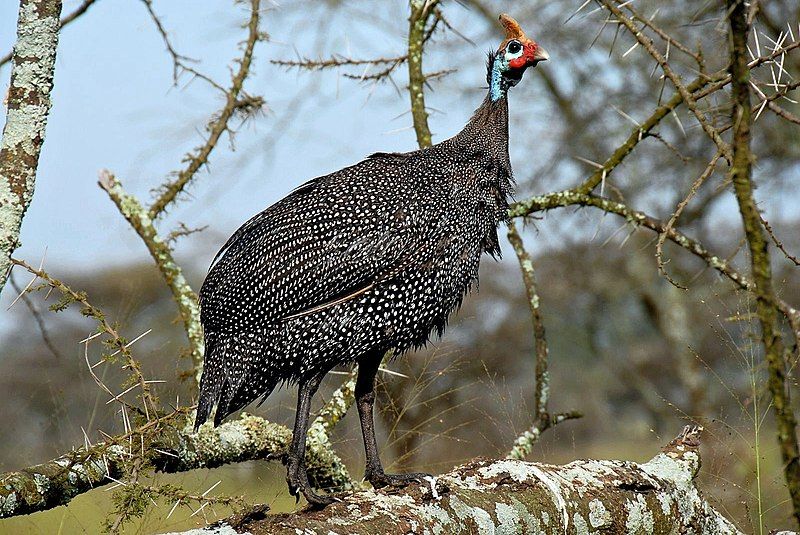
The helmeted guineafowl is a species of bird that belongs to the Numididae family and is the only member of the genus Numida. It is native to Africa, primarily south of the Sahara Desert.
Over the years, it has been domesticated and introduced into other parts such as the West Indies, North America, Colombia, Brazil, Australia, and Europe. This is why the helmeted guineafowl is the best-known and widely distributed species of the guineafowl family.
The helmeted guineafowl has a distinct appearance: a helmet-like crest of feathers on its head and a long, pointed tail. Its plumage is predominantly gray with white spots. It has strong legs and feet that enable it to move around quickly on land.
In the wild, they feed on small invertebrates such as beetles, grasshoppers, and caterpillars. They also eat seeds, fruits, and leaves. When domesticated, the helmeted guineafowl is usually kept in small backyard flocks.
They are easy to care for, and their eggs are edible. They are also used for pest control, as they can eat large insects. In conclusion, the helmeted guineafowl is a unique and fascinating bird species.
It is native to Africa but has been widely introduced into other parts of the world. Its distinctive appearance makes it easy to recognize, and its ability to adapt to different environments has allowed it to thrive in many places.
| Kingdom | Animalia |
| Phylum | Chordata |
| Class | Aves |
| Order | Galliformes |
| Family | Numididae |
| Genus | Numida |
| Species | N. meleagris |
11. Tufted Duck
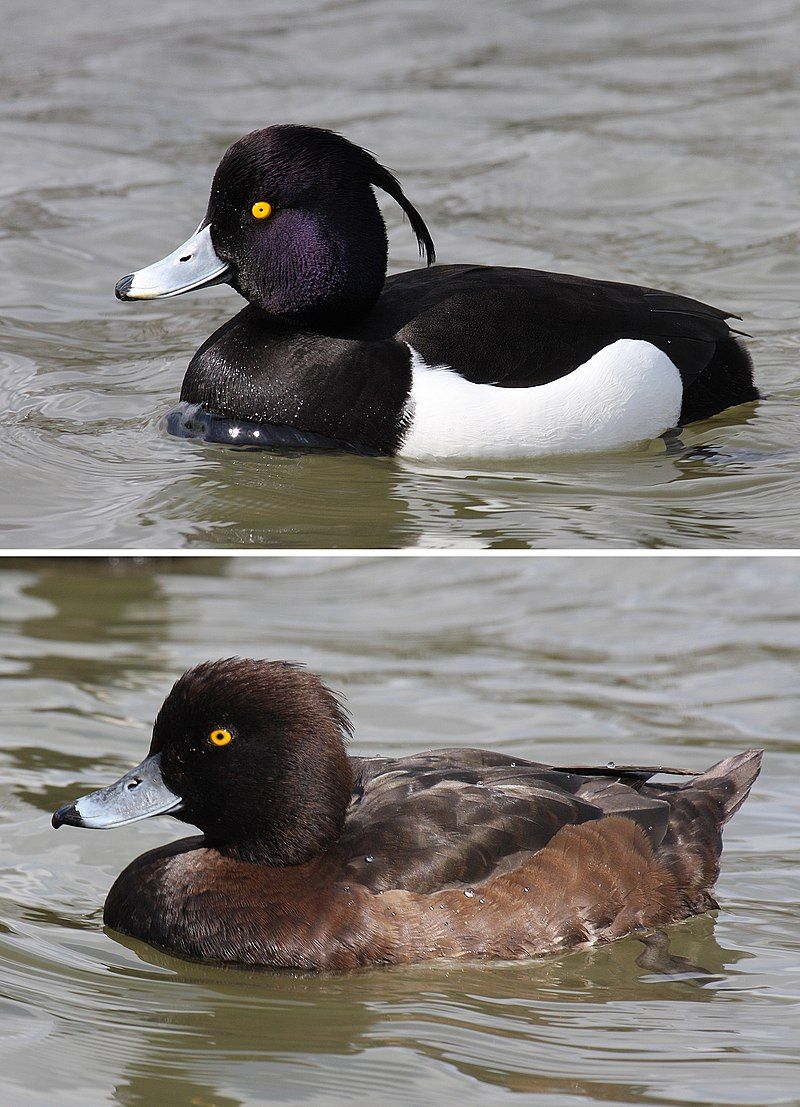
The Tufted Duck, also known as the Tufted Pochard, is a small diving duck that inhabits northern Eurasia. Its population is estimated to be close to one million birds.
The scientific name of this species is derived from Ancient Greek and Latin words that refer to the bird’s appearance. The Ancient Greek word ‘Lithuania’ referred to an unidentified seabird and was mentioned by authors such as Hesychius and Aristotle.
The Latin words ‘fuligo’ and ‘gula’ mean ‘soot’ and ‘throat’ respectively and refer to the characteristic black plumage of the tufted duck and its white throat patch. The tufted duck is a small species, usually measuring between 39 and 41 cm long and weighing up to 1.2 kg.
The male tufted duck has striking black and white plumage, a white patch on its throat, and a distinctive tuft of feathers on its head. The female is less brightly colored and has a more muted brown and grey plumage. Both sexes have yellow eyes and a blue-grey bill.
The tufted duck is a strong swimmer who can dive to depths of up to 10 m for food. Its diet consists mainly of aquatic plants, animals, and invertebrates such as mollusks and crustaceans.
| Kingdom | Animalia |
| Phylum | Chordata |
| Class | Aves |
| Order | Anseriformes |
| Family | Anatidae |
| Genus | Aythya |
| Species | A. fuligula |
12. Black Stork
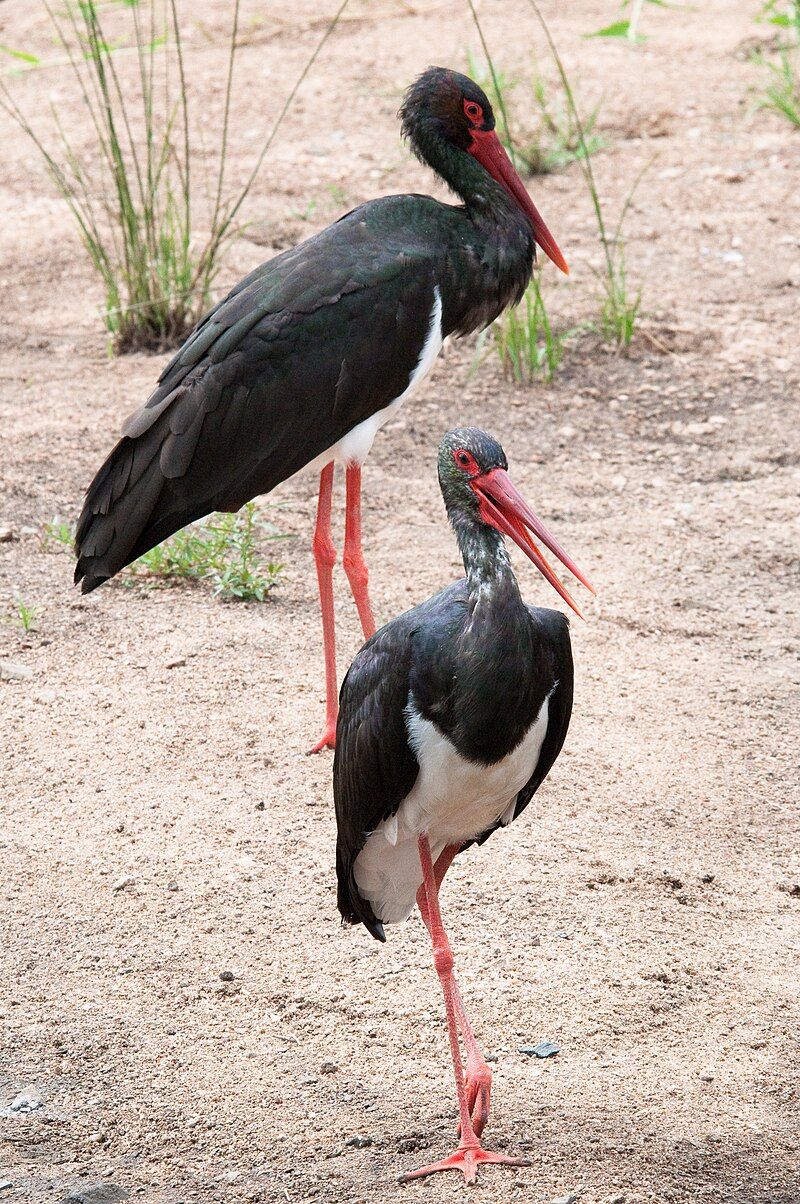
The black stork is a species of stork in the Ciconiidae family. It is a large bird with a wingspan of up to 1.5 meters.
The Swedish naturalist Carl Linnaeus first formally described the black stork in the 10th edition of his book Systema Naturae, published in 1758.
Since then, the black stork has been widely studied by ornithologists and is well-known for its unique physical features and behavior. It has black and white plumage and a long, thick neck. Its legs and feet are black, and its bill is yellow.
The black stork is a migratory bird, breeding in southern Europe and wintering in Africa. It feeds mainly on small fish, frogs, and insects. It is also known for its shy nature and is rarely seen in the open.
| Kingdom | Animalia |
| Phylum | Chordata |
| Class | Aves |
| Order | Ciconiiformes |
| Family | Ciconiidae |
| Genus | Ciconia |
| Species | C. nigra |
13. Greater Flamingo
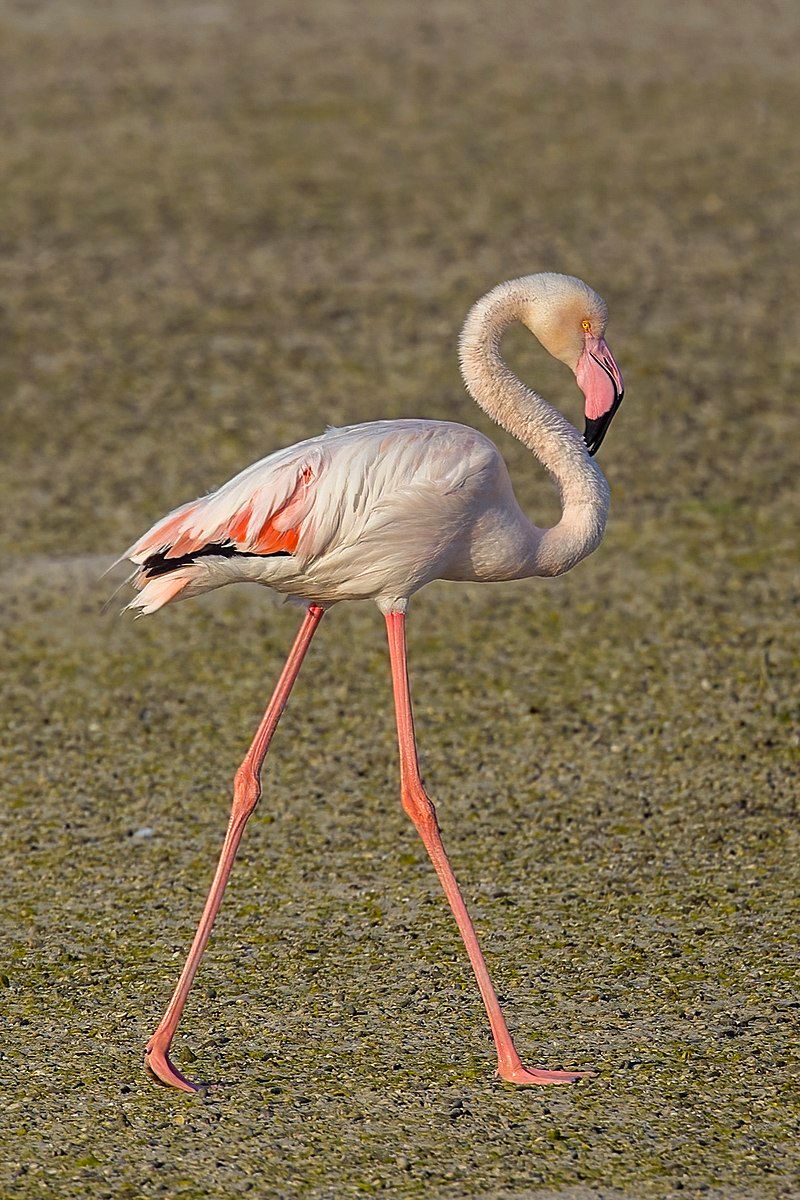
The greater flamingo is the most widespread and significant species of the family.
This bird species is commonly seen in the Old World, including parts of Africa, the Indian Subcontinent, the Middle East, the Levant, the Persian Gulf, the Gulf of Aden, the Red Sea, and the Mediterranean countries of Southern Europe.
In Africa, greater flamingos can be found in the northern and sub-Saharan regions. This includes countries such as Sudan, Ethiopia, and Somalia. In the Indian Subcontinent, they are seen in India, Pakistan, Bangladesh, and Sri Lanka.
In the Middle East, they can be spotted in countries such as Iraq, Israel, and Lebanon, while they also inhabit the Levant region. The greater flamingo is also found in the Persian Gulf, the Gulf of Aden, and the Red Sea.
The bird can also be seen in southern Mediterranean countries such as Italy, Greece, and Cyprus. Overall, the greater flamingo is a prevalent species, and their habitats stretch across many countries in the Old World.
| Kingdom | Animalia |
| Phylum | Chordata |
| Class | Aves |
| Order | Phoenicopteriformes |
| Family | Phoenicopteridae |
| Genus | Phoenicopterus |
| Species | P. roseus |
14. Knob-billed Duck
The knob-billed duck, also known as the African comb duck, is a species found in various wetland and aquatic habitats across Sub-Saharan Africa, Madagascar, South Asia, and parts of mainland Indochina.
It is a distinctive species, easily recognizable by its large bill, which has a knob-like bump at the base. Although similar in appearance to the comb duck, most taxonomic authorities classify the two species as distinct.
The knob-billed duck is a relatively large species, measuring up to 70 cm in length and weighing up to 3.2 kg. They have a brownish-grey body with a white head, neck, and breast. Males have a black bill with a distinctive knob, while females have a grey bill.
The eyes, legs, and feet are also grey. The knob-billed duck is a highly adaptable species found in various habitats, from freshwater wetlands and shallow marshes to inland lakes and rivers.
They feed on various aquatic insects, mollusks, crustaceans, amphibians, and small fish. They are also known to feed on vegetation, seeds, and fruits. The knob-billed duck is a social species and often forms large flocks, though they are not migratory.
They breed mainly during the rainy season, nesting in dense vegetation near water. The female lays between 8 and 12 eggs, which she incubates for around three weeks. The young ducks can fly and feed themselves within ten weeks of hatching.
The knob-billed duck is a common species and is not threatened with extinction. However, their populations face threats, such as habitat destruction and pollution.
To protect this species, it is essential to preserve and maintain suitable wetland habitats.
| Kingdom | Animalia |
| Phylum | Chordata |
| Class | Aves |
| Order | Anseriformes |
| Family | Anatidae |
| Genus | Sarkidiornis |
| Species | S. melanotos |
15. Levaillant’s Cuckoo
François Le Vaillant was a French explorer, collector, and ornithologist who dedicated his life to studying birds. He was commemorated by naming Levaillant’s cuckoo, a species of cuckoo native to Africa south of the Sahara.
This species is found in bushy habitats and is known for its brood parasitism, laying its eggs in the nests of bulbuls and babblers. Levaillant’s cuckoo is unique in its behavior, as it is the only brood parasite in its area.
This species is an integral part of the African ecosystem, as it plays a role in the dispersal of seeds of many plant species. Laying its eggs in the nests of other birds ensures that the young cuckoos are provided with food and shelter.
Le Vaillant’s legacy lives on in the cuckoo that bears his name, a fitting tribute to a man who dedicated his life to studying birds.
| Kingdom | Animalia |
| Phylum | Chordata |
| Class | Aves |
| Order | Cuculiformes |
| Family | Cuculidae |
| Genus | Clamator |
| Species | C. levaillantii |
16. Blue-billed Teal
The blue-billed teal, also known as the spotted teal or Hottentot teal, is a species of dabbling duck belonging to the genus Spatula.
It is found in many parts of eastern and southern Africa, ranging from Sudan and Ethiopia in the north to Niger and Nigeria in the west and south to South Africa and Namibia.
In West Africa and Madagascar, the blue-billed teal tends to be sedentary, meaning it does not migrate but stays in the same area year-round. The blue-billed teal is a medium-sized duck with a distinctive blue bill and pale gray plumage.
It can be found in various wetlands, including shallow lagoons, marshes, and floodplains. It is an omnivore, feeding mainly on seeds, insects, and crustaceans.
The blue-billed teal is a popular gamebird for hunters across its range and is also kept as an ornamental bird in aviaries.
| Kingdom | Animalia |
| Phylum | Chordata |
| Class | Aves |
| Order | Anseriformes |
| Family | Anatidae |
| Genus | Spatula |
| Species | S. hottentota |
17. Fulvous Whistling Duck
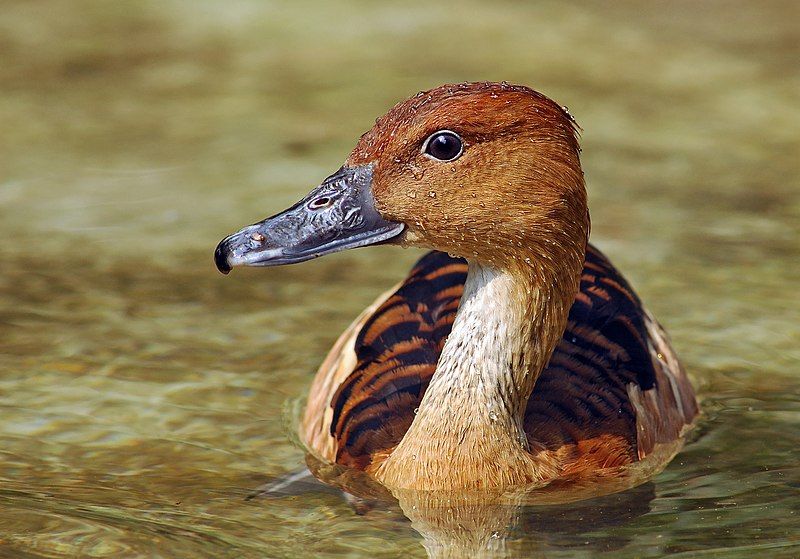
The Fulvous Whistling Duck is a species of duck found in many tropical regions worldwide. It is native to Mexico and South America, the West Indies, the southern United States, sub-Saharan Africa, and the Indian subcontinent.
The duck has a unique whistling call that can be heard echoing through wetlands and marshes, making it easier to find.
They are also called Fulvous Tree Ducks because they prefer living in trees and other tall structures. The Fulvous Whistling Duck is a medium-sized duck with a long neck and long legs.
Their head and neck are light-brown, while the wings are darker brown with white patches. They have a white chest and belly with a black bill and yellow eyes. The adult ducks have a black stripe on the back of their head and a black band across their chest.
The males and females of this species look very similar. The Fulvous Whistling Duck is a highly social species and will often live in large flocks. They feed on various aquatic plants, insects, and small fish. They are also known to eat grains, like rice and corn.
During the nesting season, the ducks will build their nests high up in trees or other tall structures, using twigs and grasses.
The Fulvous Whistling Duck is an important species to many tropical ecosystems and is currently listed as a species of most minor concern on the International Union for Conservation of Nature Red List.
They are vulnerable to habitat loss and hunting, but their numbers are stable. With continued conservation efforts, this species can thrive in its many habitats worldwide.
| Kingdom | Animalia |
| Phylum | Chordata |
| Class | Aves |
| Order | Anseriformes |
| Family | Anatidae |
| Genus | Dendrocygna |
| Species | D. bicolor |
18. Tambourine Dove
The tambourine dove is a species of pigeon native to Africa south of the Sahara Desert. These birds are found in various habitats, from woodlands to wetlands and other areas of thick vegetation.
They are common across the continent and can be seen in rural and urban areas. The tambourine dove has a distinct look, with its bright blue-grey plumage and black stripes on its wings.
Its name comes from the sound it makes, which resembles the sound of a tambourine. It is a ground-dwelling bird and prefers open habitats where it can forage for food. It feeds mainly on seeds, other plant material, and some insects.
The tambourine dove is a monogamous species; pairs often mate for life. They typically build their nests in trees, and the female will lay two eggs, hatching after an incubation period of around two weeks.
The tambourine dove is an important species in many African ecosystems, helping to disperse seeds and control insect populations.
| Kingdom | Animalia |
| Phylum | Chordata |
| Class | Aves |
| Order | Columbiformes |
| Family | Columbidae |
| Genus | Turtur |
| Species | T. tympanistria |
19. African Pygmy Goose
The African pygmy goose is a species of waterfowl native to sub-Saharan Africa. It is an example of a perching duck, a type of waterfowl closely related to dabbling ducks.
The African pygmy goose is among the smallest in the world and the smallest of Africa’s waterfowl.
It is characterized by its small size and distinctive beak, similar in shape and size to that of a goose. The African pygmy goose is found in some areas of sub-Saharan Africa, such as Ethiopia and Sudan.
It is a social species typically seen in pairs or small groups. The species prefers shallow, marshy areas and is known to feed on aquatic vegetation and seeds.
The African pygmy goose is an important species to the local ecology of its habitat, providing food for other animals and helping maintain the wetlands’ health.
The African pygmy goose is not considered threatened. However, its population is believed to have declined due to habitat loss and hunting.
Conservation efforts are in place to protect this species and its habitat and to ensure its continued survival in the wild.
| Kingdom | Animalia |
| Phylum | Chordata |
| Class | Aves |
| Order | Anseriformes |
| Family | Anatidae |
| Genus | Nettapus |
| Species | N. auritus |
20. Egyptian Goose
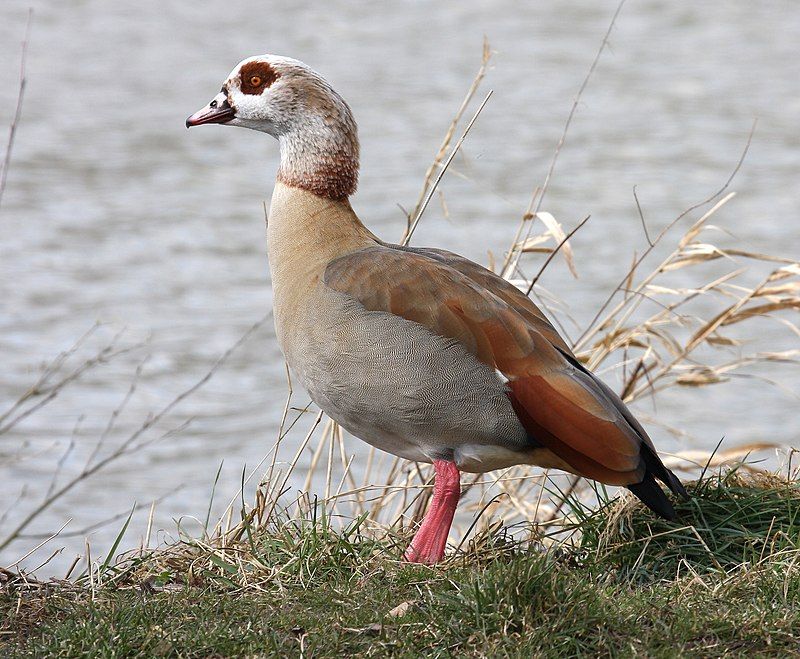
The Egyptian goose is a species of duck found in Africa. It is an Anatidae family member, including other ducks, geese, and swans.
This species is famous for its ornamental qualities, which has led to its introduction to other areas outside its natural range, such as Europe and the United States.
This introduction has been done intentionally by humans, either as a form of pest control or to introduce a new duck species into the local ecologies.
While this species is generally famous for its ornamental qualities, it can also be a pest in its new environments, as it often competes with other species for resources. As such, monitoring its introduction and spread across its new habitats is essential.
| Kingdom | Animalia |
| Phylum | Chordata |
| Class | Aves |
| Order | Anseriformes |
| Family | Anatidae |
| Genus | Alopochen |
| Species | A. aegyptiaca |
21. Little Stint
The little stint is a tiny wading bird breed in Europe’s and Asia’s Arctic regions. It is a long-distance migrant traveling to warmer areas such as Africa and South Asia during the winter.
It is also known to be a vagrant in North America and Australia, although this is not common. This bird has an interesting life cycle, migrating long distances to find the best environment for its habitat.
It can take these long journeys and adapt to different climates to be the best place for its species. The little stint is a fantastic bird that has swithng journey in order.
| Kingdom | Animalia |
| Phylum | Chordata |
| Class | Aves |
| Order | Charadriiformes |
| Family | Scolopacidae |
| Genus | Calidris |
| Species | C. minuta |
22. Harlequin Quail
The harlequin quail is an interesting species of bird in the family Phasianidae. This species is found in sub-Saharan Africa and the Arabian Peninsula. The origin of the name of this species is also quite interesting; it is derived from the collector, Adulphe Delegorgue.
Delegorgue was a French explorer who traveled extensively in sub-Saharan Africa, and his discovery of the harlequin quail was documented in his 1838 book “Voyage dans l’Afrique Australe.”
This book detailed his travels and the wildlife he encountered, including the harlequin quail. The harlequin quail is a medium-sized bird with a grayish-brown body and white spots on its wings. It has a long tail and a black-tipped crest.
These quails are typically found in open grasslands and savannas and often feed on small insects and seeds. They are also relatively low-maintenance birds and can be easily kept in captivity. Overall, the harlequin quail is an exciting bird species with a unique origin.
Its origin is linked to explorer Adolphe Delegorgue, who documented his discovery in his book. The harlequin quail is also relatively low-maintenance and can be easily kept in captivity.
Therefore, this species is an excellent option for bird owners looking for a unique and exciting pet.
| Kingdom | Animalia |
| Phylum | Chordata |
| Class | Aves |
| Order | Galliformes |
| Family | Phasianidae |
| Genus | Coturnix |
| Species | C. delegorguei |
Conclusion
The birds of Turkana are an integral part of the local landscape and culture. They provide an essential food source, a sense of place, and a connection to the broader environment.
From the small but beautiful weavers to the mighty marabou storks, the birds of Turkana are an essential part of the ecology and culture of the area.
With continued conservation and protection of the birds and their habitats, we can ensure that future generations can appreciate and enjoy these birds as much as we do.